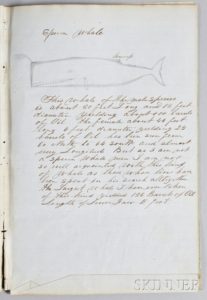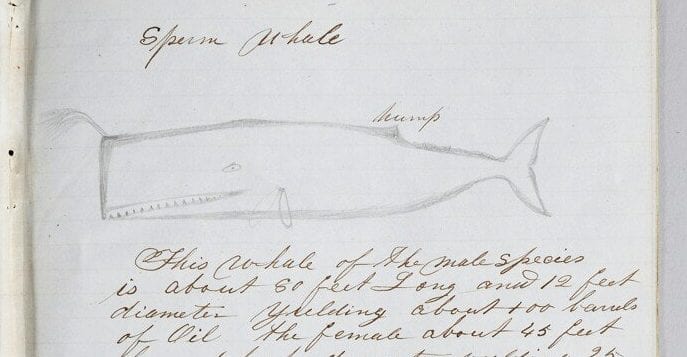Mystery solved: Beware of artifacts on eBay!
The Whaling Museum & Education Center in Cold Spring Harbor discovered that a recently purchased artifact, the first description of the natural history of whales, had been stolen from the Mariners’ Museum in Newport News, Virginia.
In spring 2016, Nomi Dayan, the Whaling Museum’s executive director, received a call from the museum’s past curator and scholar, Fred Schmitt. He alerted her that a one-of-a-kind document was up for auction: the handwritten and hand-drawn “Descriptions of Whales” created by Capt. Thomas W. Roys (1816-1877).

Considered to be the most prominent Long Island whaling captain, Roys is the American founder of the modern whaling industry. With humble beginnings as an upstate farm boy, he joined a whaling crew out of Sag Harbor as a green hand and rose to master in only eight years, devoting his life not only to hunting whales but to the scientific study of whales. Roys was an inventor of modern whaling tools — even blowing off his left hand in an experiment with the first rocket-powered harpoon and was the first American to sail through the Bering Strait as well as the first industrial whaler to discover the bowhead whale.
While commanding the Cold Spring Harbor whaleship, the Sheffield, in 1854, Roys received a query from Lt. Matthew Fontaine Maury asking about his knowledge of whale species and their habits. Roys enthusiastically responded with a detailed manuscript: a 24-sheet booklet filled with pencil drawings of whale species; his observations about their size, appearance and behavior; their products; and when and where to best hunt each species.
“This is a one-of-a-kind artifact penned by a key figure in our local and national whaling history,” said Dayan. “Not only is ‘Descriptions of Whales’ a clear snapshot of the foremost scientific understanding of whales at the time, but today the manuscript is viewed as the first whale textbook.”
The museum acquired the piece at Skinner Auctioneers for $1,599. However, when Schmitt visited the museum to view the item in person, he was struck by a sense of familiarity. He had seen the piece before — 30 years ago. It fact, there was a picture of it in a biography about Roys he had authored. When Schmitt and Dayan flipped through the book to find the photo, they were puzzled to see the image was credited to the Mariners’ Museum in Virginia. Had the document once belonged to the Mariners’ Museum? Why was the piece at an auction house? And why did the item look like it was ripped out of a larger volume?
Dayan consulted with Jeanne Willoz-Egnor, director of Collections Management at the Mariners. After sleuthing through its archive collection records, Willoz-Egnor confirmed that the piece indeed did belong to the Mariners’ Museum — and it had been internally stolen and sold.
Willoz-Egnor explained how Roy’s manuscript was one of thousands of pieces systematically stolen from the institution over a six-year period by the Mariners’ archivist, Lester Weber, who sold the items on eBay. Unprocessed and uncounted collection items were raided and items were cut from scrapbooks. To cover up his actions, he rearranged the collection’s storage area, instituted a new numbering system and methodically erased donor and acquisition information.
Astoundingly, six years of rampant thievery passed until the Mariners’ Museum received a phone call in 2006 from a collector in Switzerland. He had purchased a number of the items through eBay and had become suspicious about the never-ending source of such high-quality materials. Weber’s eBay account was listed under his wife’s maiden name, Lori Childs, which never yielded any information in internet searches by the collector. However, when Childs happened to include her middle initial on a return address on one occasion, the collector was finally able to link her name online to an obituary about her mother where there was mention of Lester Weber, who worked at none other than the Mariners’ Museum.
An investigation led to Weber’s termination, who continued to sell stockpiled stolen artifacts even after his arrest. Research indicated at least 6,456 items were removed from the collection between 2000 and 2006. In 2008, Weber and Childs both pled guilty to more than two dozen counts, including theft. In 2008, Weber was sentenced to four years in prison, his wife to 15 months, and was ordered to make restitution of the $172,357 he made from the sales, even though the museum valued the stolen items at $500,000. Weber was released from prison in June 2012.
Today, 5,500 pieces remain unaccounted for, but “Descriptions of Whales” will be returning to its original home. The finding also led to the detection of several other items that had been stolen from the Mariners’ Museum and were sold in the same auction lot, including the 1776 logbook of the whaling ship, the Minerva.
Howard H. Hoege III, the president and CEO of Mariners’, stated, “It is difficult to fully express how grateful we are to The Whaling Museum & Education Center at Cold Spring Harbor for their diligence and compassion regarding the Roys manuscript. All of us at The Mariners’ Museum were incredibly proud and humbled that our fine colleagues in Cold Spring Harbor would go to the lengths that they did in an effort to make us whole.”
“Uncovering the circumstances behind this item’s whereabouts was bittersweet,” said Dayan. “It is unfortunate for our museum to lose this tremendous scholarly importance to our collection, but rewarding to do the right thing and return this object home.”
The Whaling Museum & Education Center, located at 301 Main St., Cold Spring Harbor, specializes in the culture and history of local maritime heritage as illustrated by the Cold Spring Harbor whaling industry of the 1850s. Learn more at www.cshwhalingmuseum.org.





